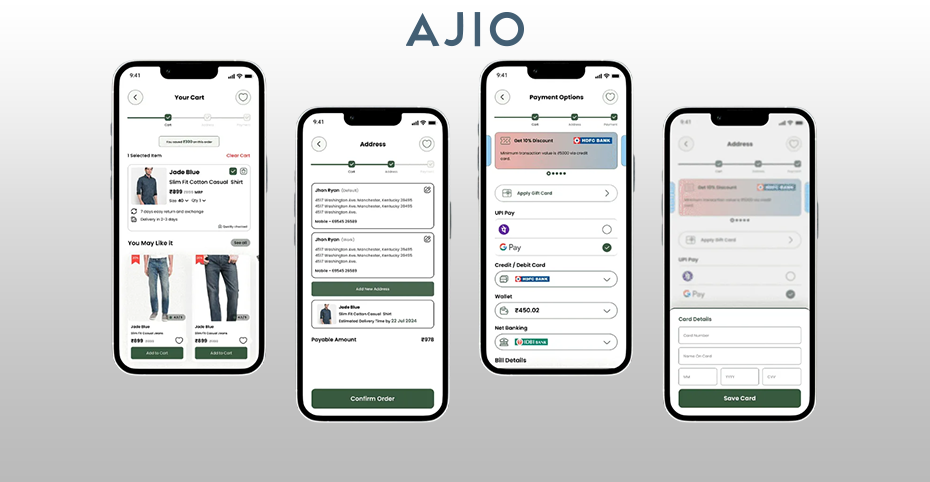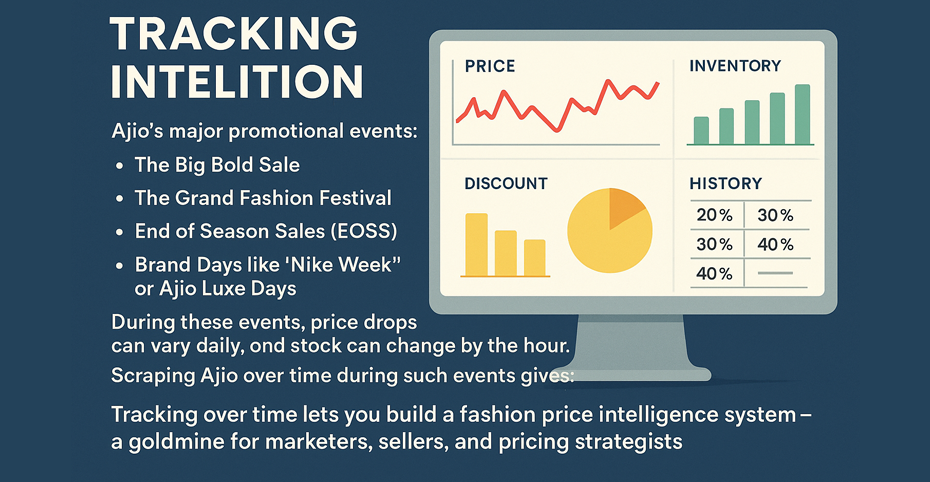
Web Scraping Ajio: Analyzing Indian Fashion E-Commerce Trends
May 09 , 2025
Introduction
India’s e-commerce landscape has transformed dramatically over the past decade, with fashion being one of its most dynamic sectors. Among the top contenders reshaping this space is Ajio, a fashion-forward online marketplace owned by Reliance Retail. Known for its curated collections, trendy apparel, global brands, and deep discounts, Ajio has carved out a strong presence in both metro cities and tier-II/III towns.
In an era where data-driven decision-making defines success in retail and marketing, having real-time access to Ajio's vast product database can be a goldmine for businesses. From identifying emerging trends to evaluating pricing strategies and analyzing customer preferences, web scraping Ajio opens up a powerful avenue for market intelligence.
This blog will serve as a comprehensive 7000-word guide for beginners and professionals alike who want to:
- Understand how to extract valuable data from Ajio.com
- Track discounts, seasonal trends, and product availability
- Compare fashion brand performance and popularity
- Use scraped data for business, marketing, or academic insights
- Stay compliant with legal and ethical standards
Understanding Ajio’s E-Commerce Ecosystem
The Rise of Ajio in India’s Fashion Market
- Offering curated international brands like Superdry, Diesel, and Armani Exchange
- Highlighting private labels and exclusive Reliance-owned brands
- Aggressive pricing strategies and regular mega sales like “Ajio Big Bold Sale”
- Capitalizing on Reliance’s massive supply chain infrastructure
Key Categories That Define Ajio’s Fashion Data

- Men’s and Women’s Apparel (casuals, formals, ethnic wear)
- Footwear (sneakers, sandals, heels, boots)
- Accessories (bags, belts, jewelry)
- Brands – From Adidas and Puma to indie and emerging labels
- Deals and Discounts – Often highlighted prominently with % off banners
Why Scrape Ajio and What Data to Extract
Who Can Benefit from Scraping Ajio?
- Fashion Brands and D2C Labels: Benchmark pricing and discounting strategies against Ajio’s listings.
- Market Researchers and Analysts: Track consumer behavior and evolving preferences.
- E-Commerce Competitors: Scrape to compare inventory sizes, pricing tiers, and new arrivals.
- Price Comparison Platforms: Aggregate and update real-time prices and deals.
- Fashion Bloggers and Influencers: Spot emerging fashion trends before they hit the mainstream.
What Data Can Be Scraped from Ajio?
| Data Point | Why It Matters |
|---|---|
| Product Name | Key for trend analysis, categorization, and indexing |
| Brand Name | Essential for brand-level analytics and comparisons |
| Product Category | Allows for filtering and segmentation by apparel, footwear, etc. |
| Price (MRP and Discounted) | Enables price comparison, discount tracking, and pricing trend forecasting |
| Discount Percentage | Monitor promotional strategies across brands and events |
| Ratings and Reviews | Customer sentiment, satisfaction, and feedback |
| Stock Availability | Indicates demand; sold-out tags reveal popularity |
| Size Availability | Shows size demand or shortages |
| Images & Product Banners | For visual trend and UI/UX analysis |
| Color and Material | Forecasting preferences and design trends |
| Tags (e.g., "New Arrival") | Detect seasonal lines and latest collections |
| Product URL | Unique identifier and direct link for tracking |
Types of Scraping: Static vs Dynamic Pages
Ajio’s website has a mix of static and dynamically loaded content.
- Static content (like image URLs, basic text) can be scraped using BeautifulSoup and requests.
- Dynamic content (like prices changing with offers, size availability, or AJAX-loaded reviews) requires tools like Selenium or Playwright to render JavaScript.
You'll often need a hybrid scraping strategy, especially during sales periods when the UI structure can shift.
Scraping Ajio’s Sales Events and Campaigns

Ajio’s major promotional events include:
- The Big Bold Sale
- The Grand Fashion Festival
- End of Season Sales (EOSS)
- Brand Days like “Nike Week” or “Ajio Luxe Days”
During these events, price drops can vary daily, and stock can change by the hour. Scraping Ajio over time during such events gives:
- Hourly/daily pricing history
- Inventory depletion patterns
- Discount benchmarks
Ethical Data Focus
- Avoid personal data (like user accounts or checkout flows)
- Respect fair-use thresholds
- Focus only on product-level metadata, not sensitive backend content
Tools, Libraries, and Setup for Scraping Ajio
Best Tools for Web Scraping Ajio
- Python – The most popular language for web scraping due to its simplicity and powerful libraries.
- Requests – For sending HTTP requests and receiving responses.
- BeautifulSoup – HTML parser for extracting data.
- Selenium – Automates browsers and renders dynamic content.
- Playwright – Faster alternative to Selenium for handling AJAX content.
- Pandas – For storing and analyzing scraped data.
- Jupyter Notebook or VS Code – To write, test, and debug scraping scripts.
Setting Up Your Python Environment
# Step 1: Create a virtual environment (optional but recommended)
python -m venv ajio_scraper_env
source ajio_scraper_env/bin/activate # Windows: .\ajio_scraper_env\Scripts\activate
# Step 2: Install essential libraries
pip install requests beautifulsoup4 pandas selenium playwright
# To install Playwright browsers
playwright install
Inspecting Ajio’s Website for Scraping
Visit: Ajio Men’s Shoes
- Open the page in Chrome.
- Right-click a product title or price and select “Inspect”.
- Review HTML tags, classes, and attributes.
<div class="rilrtl-products-list__item">
<a href="/nike-grey-sneakers/p/460119112">
<div class="brand">Nike</div>
<div class="name">Grey Sneakers</div>
<div class="price">₹3,299</div>
<div class="discount">40% Off</div>
</a>
</div>
Basic Web Scraping Code for Ajio (Static Content)
import requests
from bs4 import BeautifulSoup
url = 'https://www.ajio.com/men-sneakers/c/830216001'
headers = {
'User-Agent': 'Mozilla/5.0 (Windows NT 10.0; Win64; x64)'
}
response = requests.get(url, headers=headers)
soup = BeautifulSoup(response.text, 'html.parser')
products = soup.find_all('div', class_='rilrtl-products-list__item')
for product in products:
brand = product.find('div', class_='brand').text.strip()
name = product.find('div', class_='name').text.strip()
price = product.find('div', class_='price').text.strip()
print(f"Brand: {brand}, Name: {name}, Price: {price}")
⚠️ Note: Ajio dynamically loads many elements. Selenium or Playwright is required for full scraping.
Scraping with Selenium (For Dynamic Content)
from selenium import webdriver
from selenium.webdriver.chrome.service import Service
from selenium.webdriver.common.by import By
service = Service('path/to/chromedriver')
driver = webdriver.Chrome(service=service)
driver.get('https://www.ajio.com/men-sneakers/c/830216001')
driver.implicitly_wait(10)
products = driver.find_elements(By.CLASS_NAME, 'rilrtl-products-list__item')
for product in products:
brand = product.find_element(By.CLASS_NAME, 'brand').text
name = product.find_element(By.CLASS_NAME, 'name').text
price = product.find_element(By.CLASS_NAME, 'price').text
print(f"Brand: {brand} | Name: {name} | Price: {price}")
driver.quit()
Conclusion: Unlocking Fashion Intelligence Through Ajio Web Scraping
As India’s fashion e-commerce market continues to thrive, platforms like Ajio play a critical role in defining how consumers shop, how trends emerge, and how brands position themselves in a crowded digital space. With millions of product listings, frequent promotions, and a wide spectrum of brands—from global icons to local independents—Ajio is a goldmine of actionable retail data.
- Businesses can benchmark pricing and optimize inventory
- Researchers can analyze trends and consumer behavior
- Startups can build price trackers and recommendation engines
- Fashion analysts can forecast seasonal and regional trends
By leveraging powerful tools like Python, Selenium, BeautifulSoup, and Playwright, even non-enterprise users can build smart, scalable scrapers that fetch data in real time. Whether you’re tracking deals on kurtas, analyzing color trends in footwear, or benchmarking price drops during the Big Bold Sale, Ajio’s data, if extracted ethically and strategically, can unlock a competitive edge.
However, with great data comes great responsibility. Always ensure your scraping activities are legal, respectful of platform terms, and optimized to prevent performance impact on the host site.
In conclusion, web scraping Ajio isn’t just about collecting numbers—it’s about decoding consumer behavior, forecasting fashion trends, and staying one step ahead in India’s fast-paced e-commerce battlefield. Done right, it becomes the foundation for smarter business decisions and deeper retail insights.

